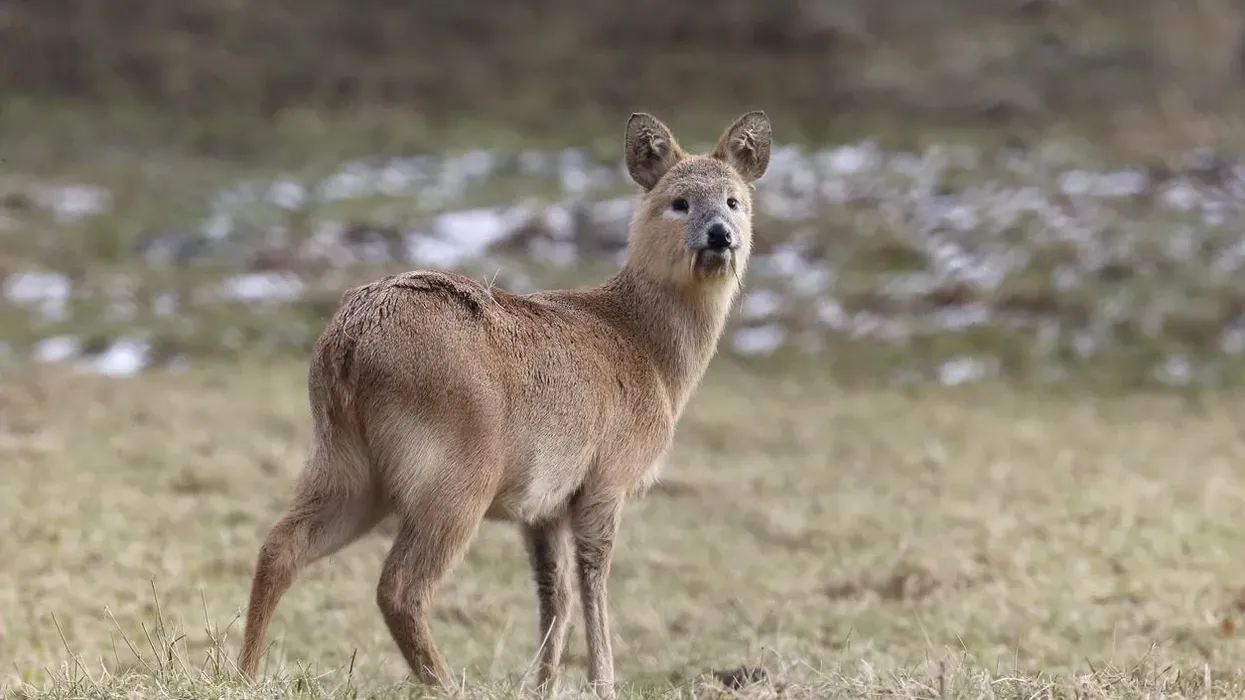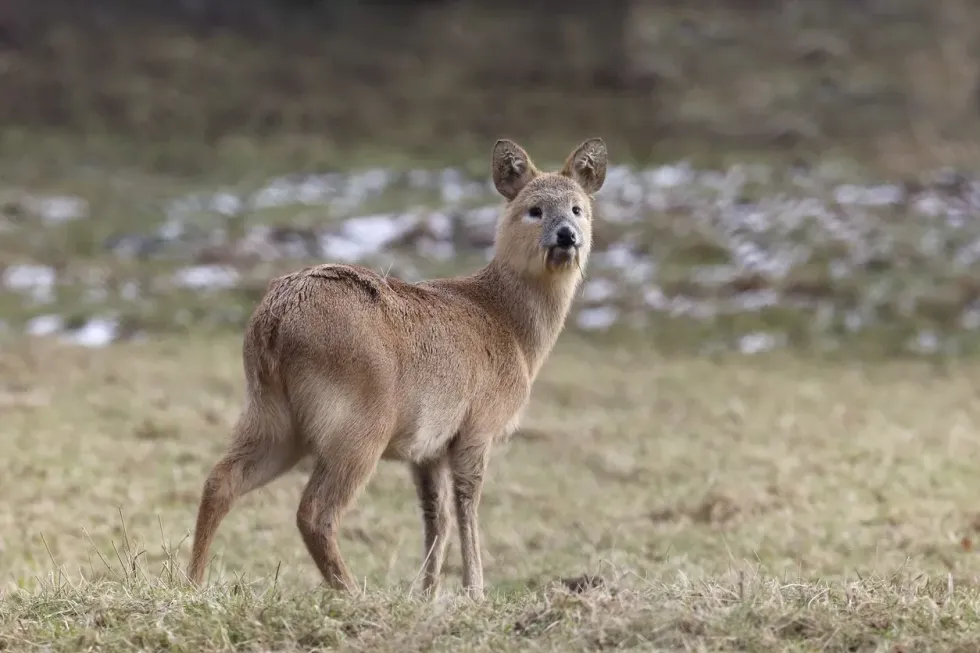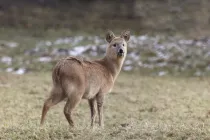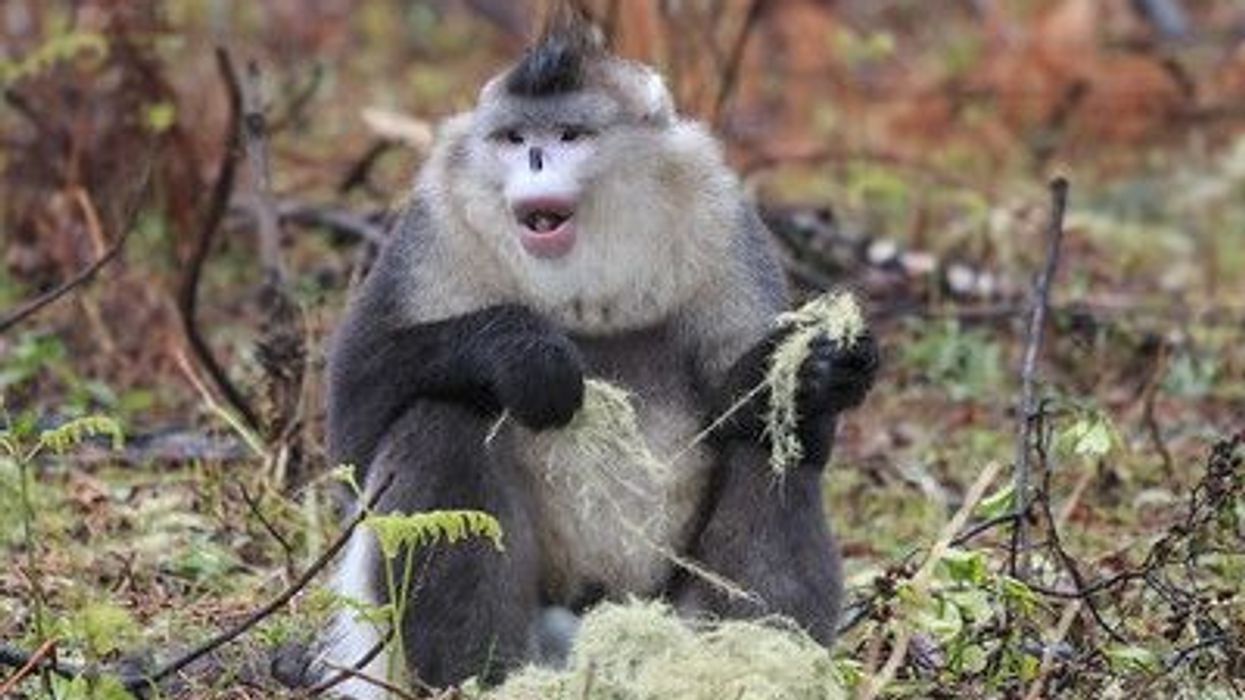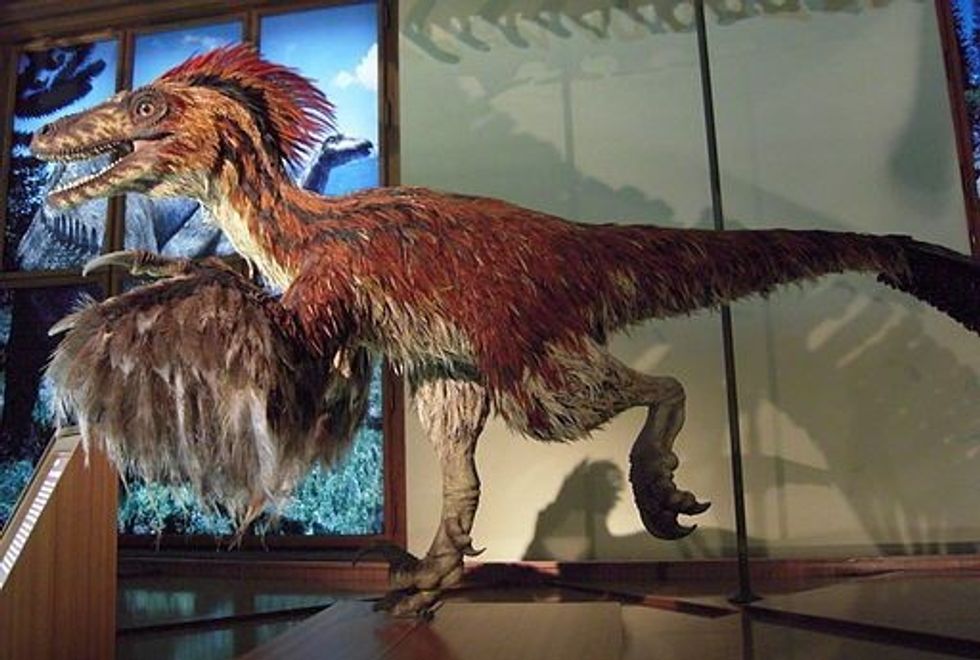Fun Chinese Water Deer Facts For Kids

Content
- What type of animal is a Chinese Water deer?
- What class of animal does a Chinese Water deer belong to?
- How many Chinese Water deers are there in the world?
- Where does a Chinese Water deer live?
- What is a Chinese Water deer's habitat?
- Who do Chinese Water deers live with?
- How long does a Chinese Water deer live?
- How do they reproduce?
- What is their conservation status?
- What do Chinese Water deers look like?
- How cute are they?
- How do they communicate?
- How big is a Chinese Water deer?
- How fast can a Chinese Water deer run?
- How much does a Chinese Water deer weigh?
- What are their male and female names of the species?
- What would you call a baby Chinese Water deer?
- What do they eat?
- Are they aggressive?
- Would they make a good pet?
- Did you know...
- Why do Chinese water deer have fangs?
- Can you eat Chinese water deer?
The Chinese water deer is a musk deer animal with a pair of tusks and classified under Cervid. The Chinese water deer lack antlers and instead have tusks or fangs. The Korean water deer is a close relative of the Chinese water deer Hydropotes Inermis.
Water deer are unsociable. If they are disturbed, they hump their back and moves in a sequence by jumping. They are known to alert each other in case of approaching danger. They make a slight barking sound that serves as a warning. The alarm is shrill.
The water deer bucks rub their forehead on the tree trunks to mark it as their territory. Although no forehead glands are found on the tree trunks, their companions can identify that this territory is already occupied.
Another scent marking is the interdigital glands left by the deer species by pawing on the ground. The dung of the deer also acts as a scent marking.
If you enjoy this article, check out the plains zebra and the Friesian?
Chinese Water Deer Interesting Facts
What type of animal is a Chinese Water deer?
As the name suggests, the Hydropotes Inermis is native to China and can swim several kilometers and move backward and forward in between the reefs to cover themselves and search for food.
This native Chinese deer species, Hydropotes Inermis, has quiet and shy behavior. It hides from its enemies in dense vegetation.
They like being alone and don't like being close to other animals of their species to be near them. Water deers defend their territories aggressively from their rivals. Only one or two female deer can be near them and sleep within their territories, and they can even accompany them to search for food.
When the bucks fight with one another, they stand parallel and the heads at the shoulder level. They try to attack their rivalry on the neck and shoulders with their fangs' help by swinging their heads.
Their fight can sometimes lead to tearing up their skin and hair, causing dangerous wounds. The bucks become more aggressive during the mating season.
If the opponent buck is defeated, he should surrender; otherwise, he might be driven out of the territory or maybe killed. The defeated bucks' surrendering includes placing their head and neck flat on the ground.
What class of animal does a Chinese Water deer belong to?
The Chinese water deer belongs to mammal and the family Cervidae.
How many Chinese Water deers are there in the world?
In the past, Chinese water deer were found in abundance. At present, only 10,000 water deer are believed to be found in the wild.
The population of water deer's in different regions of China- Zhoushan Islands in Zhejiang region (600-800), Jiangxi regions of Guangdong, Poyang Lake and Fujian (1000), Jiangsu (500-1000), Hubei (500), Henan (500) and Anhui (500). In Shanghai, the Chinese water deer, Hydropotes Inermis, was 21 individuals in 2007 to 227-299 in 2013.
Where does a Chinese Water deer live?
The water deer Hydropotes Inermis lives in the woods, wetlands, mountains, swamps, and grasslands. They are native to China and are found in east-central China in the lower Yangtze Basin, Yancheng coastal wetlands, coastal Jiangsu province, Zhejiang Islands, and Korea. This deer species was also introduced in the wilds of France and England.
The Korean water deer is one of the subspecies of the Chinese water deer and is known as Hydropotes Inermis Argyropus (Gorani). They are widely distributed in Korea, and their habitat is protected.
What is a Chinese Water deer's habitat?
The water deer Hydropotes Inermis live near the river with tall reeds and rushes and mountains with tall grasses. Sometimes they are also found on the cultivated land, grasslands, and swamps. They prefer those cultivated lands that are cut and often lie in the fields, furrows, and hollows. This Chinese water deer Hydropotes are proficient in hiding.
The Hydropotes Inermis are excellent swimmers and can make several miles to reach the remote islands. This deer species is now even found in the United States, France, United Kingdom, and Argentina. They are native to the fertile river areas of China and Korea.
Who do Chinese Water deers live with?
This water deer, Chinese Hydropotes Inermis, usually live on their own. Sometimes found in pairs with their female species.
The water deer don't form any herds. But you can see them in groups when grazing and feeding.
How long does a Chinese Water deer live?
The Chinese water deer has an average lifespan of 10-12 years.
How do they reproduce?
During November and December months, the males follow the females for mating. They often make soft squeaking sounds to communicate. The water deer check for the rut or oestrus by lowering their neck, rotate their head, and flap their ears. The scent of the water deer plays a significant role in coupling with both the sexes sniffing each other.
The mating in water deer is polygynous in which males mate with many females. The coupling occurs for a brief period and within the males' territorial area.
The water deer can give birth to up to seven young fawns. The females are often found to give birth in open spaces and take away to a hiding place where the young ones live there for a month.
After that, they come out to play. Even after being driven from their birth area, the young fawns continue to be together. Later, when they become mature, they continue with their solitary existence.
What is their conservation status?
The conservation status of Chinese water deer is Vulnerable. They are usually hunted in the wild in large numbers. According to recent data, though they are currently not categorized as endangered, only 10,000 individuals are found in China's wilds.
Chinese Water Deer Fun Facts
What do Chinese Water deers look like?
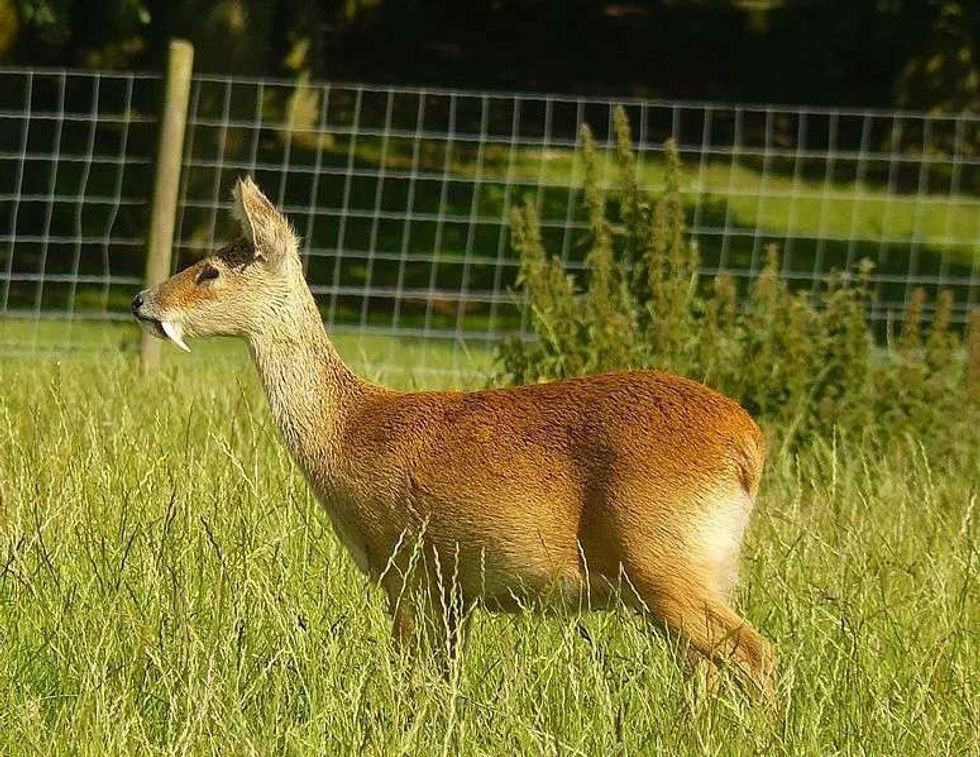
The water deer are small in size, about 30.51 - 39.37 in (77.5 - 1oo cm ) in length. Their hair is thick and rough. Its hind legs are the longest, and the rest of the leg is 40 mm.
The face is reddish-brown, and the chin and the upper part of the throat are whitish. The backside of the body is yellowish-brown, and the underpart is white. The young ones are born in dark brown.
Both the males and female deer species lack antlers. So, they have fangs instead of antlers, and the fangs of the males are enlarged, long, and the tusks are slightly curved. The Chinese water deer teeth are 52 mm in length that start from the upper jaw.
It acts as a sharp weapon. The females' canine teeth, like a tusk, are smaller, and it is only 5 mm on the inner side.
This deer species with the fangs like tusks is one of the unique deer species. You can also find a dark spot on the lower lip right behind the teeth's, making it a more prominent feature. Also, both sexes have scent glands in front of the eyes.
How cute are they?
Yes, the water deer Hydropotes Inermis is very cute. They are small and compressed in size with rounded eyes. They lack antlers but have long teeth like a tusk. They are reddish-brown with whitish hair on the chin and upper part of the throat.
How do they communicate?
The Chinese water deer Hydropotes can produce many sounds. They usually bark with a howling sound. This barking sound is an alarm to warn its companions about the approaching danger.
During the mating season, the busks make a clicking sound to attract the does. It is believed that they make this clicking sound with their molar teethes. The bucks are found following the does and make a squeaking or soft whistling sound. In case a water deer is injured, they would make a groaning cry.
How big is a Chinese Water deer?
The Chinese water deer Hydropotes is small. Its body length is 30.51 - 39.37 in (77.5 - 100 cm), shoulder height is 18 - 22 in (42 – 65 cm), and tail length 2.4 - 3 in (6 - 7.5 cm) .
It is five times smaller than a moose, the largest deer.
How fast can a Chinese Water deer run?
The water deer can run fast. But it is more like hopping with their back legs instead of running. They love the water and are excellent swimmers. They cover long-distance areas without even getting tired. It is one reason why the Chinese water deer has spread from China to Korea.
How much does a Chinese Water deer weigh?
The Chinese water deer has an average weight of 20-31 lb (9–14 kg ). At birth, the young fawns are 2 lb (1 kg). The water deer is a small animal.
What are their male and female names of the species?
Male Chinese water deer are known as bucks, and female Chinese water deer are known as does.
What would you call a baby Chinese Water deer?
The newborn Chinese water deer is known as a fawn.
What do they eat?
So what do Chinese water deer eat? The Chinese water deer's diet comprises coarse grasses, vegetables, reeds, and beets. They look for food in the morning and evening.
Although the Chinese water deer Hydropotes have a four-chamber stomach, the rumen pillars are very weakly developed. The water deer cannot digest the plants' carbohydrates because of these weak rumen pillars.
Are they aggressive?
Chinese water deer are not dangerous or hostile towards humans, but they can be aggressive to other animals. The Chinese water deer attack their opponents with their tusks.
Also, use the tusks to protect themselves from their predators. However, unlike other deer with antlers, their fighting is not hostile, and killing is not involved. Only their canine teeth-like tusks cause injury and removal of their opponents' skin and hair.
The bucks are highly aggressive and territorial. They have various ways of marking their areas. They use their forehead to rub on the trees or bite the bushes' reeds and branches. Also, the bucks claim their area with the scent of their urine and feces.
The bucks also become aggressive during the mating season and fight with their opponents over females. The bucks use their fangs to scratch and bite off the skin and hair. It is pretty common to see them with torn ears and injured skin.
The females are not aggressive and don't get involved in territorial or dominant battles. They only chase other females from their territories after giving birth to ensure their young fawns' safety.
Would they make a good pet?
Yes, they would make a good pet, and you can find them in the farmhouses of some people. The deer can be a good and obedient pet with the right type of owners. When raised by humans and taught how to socialize, they don't act wild.
Did you know...
The bucks have fighting rituals. When they fight for dominance, they approach each other in parallel positions with their heads near their shoulders. The wounds are serious, like the tearing of hair and skin, but not fatal. The defeated buck will have to surrender by laying his head and neck flat on the ground.
The nickname of water deer is Vampire deer. The reason is due to its long canine teeth's that look like tusks.
All the water deer have fangs. But all the fanged deer are not water deer. Other species like musk deer, muntjac deer, and tufted deer don't look like the water deer, but they do have long canine teeth.
The does can carry seven young fawns for six to seven months; this is one of the unique features of water deer.
The males gain maturity when they are five to six months and the females at seven to eight months.
The water deer swims for miles to reach far-off islands searching for rich food.
Why do Chinese water deer have fangs?
The males use their tusks for dominant battles. The Chinese water deer are herbivores, so you won't find them tearing off a predators' skin with their tusks. They usually look like defensive weapons to flee their predators.
The Chinese water deer use their fangs to chew the leaves or break tree branches and bushes to mark their territorial areas. The tusks start to grow when they are around 6 months old.
Can you eat Chinese water deer?
It is the best venison you will get to eat. Its meat is paler than the typical deer's, but it is twice as delicious.
The venison has a little fat, but the Chinese water deer has more fat at the back, and it is less dry than the venison of other species. Some people have described that it tastes more like a lamb than venison.
Here at Kidadl, we have carefully created lots of interesting family-friendly animal facts for everyone to discover! Learn more about some other mammals including reindeer and key deer.
You can even occupy yourself at home by drawing one of our Chinese water deer coloring pages.
We Want Your Photos!
More for You
See All
Bachelor of Science specializing in Mass Communication.

Adekunle Olanrewaju JasonBachelor of Science specializing in Mass Communication.
Disclaimer
1) Kidadl is independent and to make our service free to you the reader we are supported by advertising. We hope you love our recommendations for products and services! What we suggest is selected independently by the Kidadl team. If you purchase using the Buy Now button we may earn a small commission. This does not influence our choices. Prices are correct and items are available at the time the article was published but we cannot guarantee that on the time of reading. Please note that Kidadl is a participant in the Amazon Services LLC Associates Program, an affiliate advertising program designed to provide a means for sites to earn advertising fees by advertising and linking to Amazon. We also link to other websites, but are not responsible for their content.
2) At Kidadl, we strive to recommend the very best activities and events. We will always aim to give you accurate information at the date of publication - however, information does change, so it’s important you do your own research, double-check and make the decision that is right for your family. We recognise that not all activities and ideas are appropriate for all children and families or in all circumstances. Our recommended activities are based on age but these are a guide. We recommend that these ideas are used as inspiration, that ideas are undertaken with appropriate adult supervision, and that each adult uses their own discretion and knowledge of their children to consider the safety and suitability. Kidadl cannot accept liability for the execution of these ideas, and parental supervision is advised at all times, as safety is paramount. Anyone using the information provided by Kidadl does so at their own risk and we can not accept liability if things go wrong.
3) Because we are an educational resource, we have quotes and facts about a range of historical and modern figures. We do not endorse the actions of or rhetoric of all the people included in these collections, but we think they are important for growing minds to learn about under the guidance of parents or guardians.
